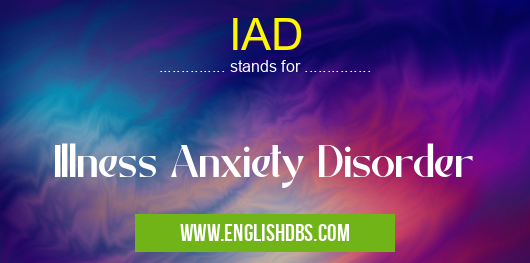What does IAD mean in CLINICAL MEDICINE
Illness Anxiety Disorder (IAD), formerly known as hypochondriasis, is a psychiatric condition characterized by an excessive and persistent fear of having or developing a severe illness. Individuals with IAD experience preoccupation with their health, misinterpreting normal bodily sensations or minor symptoms as signs of a serious illness.

IAD meaning in Clinical Medicine in Medical
IAD mostly used in an acronym Clinical Medicine in Category Medical that means Illness Anxiety Disorder
Shorthand: IAD,
Full Form: Illness Anxiety Disorder
For more information of "Illness Anxiety Disorder", see the section below.
Meaning of IAD
IAD stands for Illness Anxiety Disorder. It is a mental health condition that involves an intense fear of having a serious illness or disease. Individuals with IAD often have unrealistic beliefs about their health and may experience excessive worry, anxiety, and distress related to their perceived symptoms.
Symptoms of IAD
- Excessive worry about having or developing a serious illness
- Misinterpretation of bodily sensations as signs of illness
- Repeated visits to doctors and healthcare professionals
- Excessive self-examination for physical signs of illness
- Avoidance of activities due to fear of illness exposure
- Difficulty concentrating and making decisions
- Fatigue, muscle tension, and irritability
Causes of IAD
The exact causes of IAD are unknown, but several factors may contribute to its development, including:
- Genetic predisposition: Some individuals may be more likely to experience anxiety and health-related concerns.
- Personality traits: Individuals who are perfectionistic, self-critical, and have a negative self-image may be at higher risk.
- Life experiences: Traumatic events or experiences related to illness or medical problems can trigger IAD.
- Cognitive distortions: Individuals with IAD often hold distorted beliefs about health, illness, and their own bodies.
Treatment for IAD
Treatment for IAD typically involves psychotherapy, such as:
- Cognitive-behavioral therapy (CBT): CBT helps individuals identify and challenge their distorted health beliefs and develop coping mechanisms for managing anxiety.
- Exposure and response prevention (ERP): ERP gradually exposes individuals to situations that trigger their anxiety related to illness, while teaching them to tolerate these feelings and reduce avoidance behaviors.
- Medication: In some cases, antidepressants or anti-anxiety medications may be prescribed to help manage symptoms.
Essential Questions and Answers on Illness Anxiety Disorder in "MEDICAL»CLINICAL"
What is Illness Anxiety Disorder (IAD)?
Illness Anxiety Disorder (IAD) is a mental health condition that causes excessive worry and fear about having a serious illness. People with IAD may misinterpret normal physical sensations or minor symptoms as signs of a life-threatening condition.
What are the symptoms of IAD?
Symptoms of IAD may include:
- Persistent worry about having a serious illness, despite medical reassurance
- Excessive checking of the body for signs of illness
- Frequent visits to doctors and hospitals for medical check-ups
- Avoidance of situations or activities due to fear of illness
- Distress or impairment in daily functioning.
What causes IAD?
The exact cause of IAD is unknown, but it is thought to involve a combination of factors, including:
- Family history of anxiety disorders
- Negative health experiences
- Personality traits, such as perfectionism and hypochondriasis
- Biological factors, such as an imbalance in brain chemistry.
How is IAD diagnosed?
IAD is diagnosed by a mental health professional based on a psychological evaluation. Diagnostic criteria include:
- Excessive worry about having a serious illness
- An absence of physical evidence to support the worry
- The worry causes significant distress or impairment in daily functioning.
How is IAD treated?
Treatment for IAD typically involves a combination of therapy and medication. Therapy, such as cognitive behavioral therapy (CBT), helps individuals challenge negative thoughts and behaviors related to their health anxiety. Medication, such as antidepressants, can help reduce anxiety symptoms.
How can I help someone with IAD?
If you know someone with IAD, you can provide support and encouragement.
- Listen to their concerns without judgment.
- Help them understand IAD and its symptoms.
- Encourage them to seek professional help.
- Reassure them that they are not alone.
Final Words: Illness Anxiety Disorder (IAD) is a debilitating condition that can significantly impact an individual's life. By understanding the meaning and causes of IAD, individuals and healthcare professionals can work together to develop effective treatment strategies. With appropriate treatment, individuals with IAD can learn to manage their anxiety, reduce their health-related worries, and improve their overall well-being.
IAD also stands for: |
|
| All stands for IAD |
